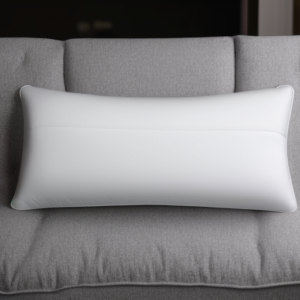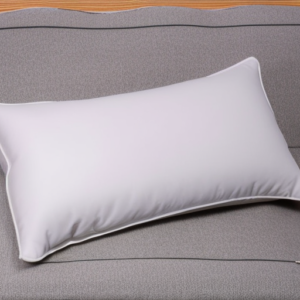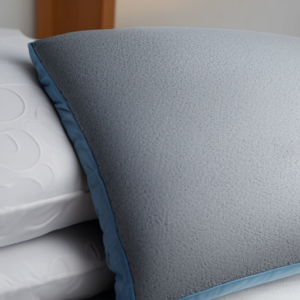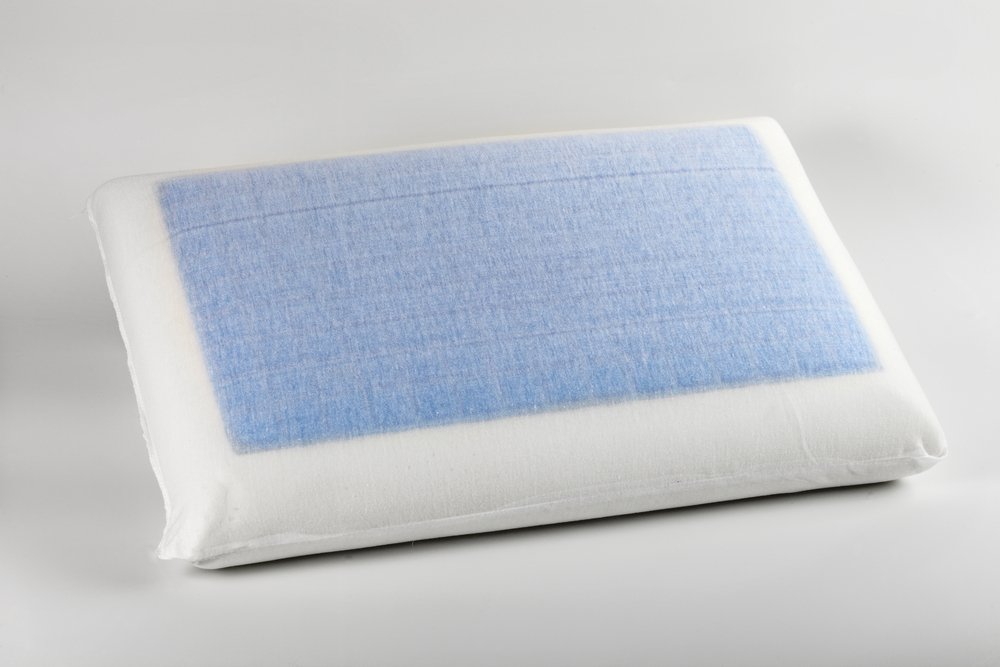Last Updated on February 14, 2023
Are you worried about how your new memory foam pillow smells? Do memory foam pillows smell bad, or is it just something that comes with the territory of buying a luxurious piece of bedding? Well, no need to worry – we have all the answers for you. In this blog post, we’ll discuss what causes these odours in memory foam pillows and provide some tips on reducing them. So if “why do memory foam pillows smell” has been keeping you up at night (literally.), read on and get ready to sleep soundly again.
Table of Contents:
- What Causes Memory Foam Pillows to Smell?
- How to Reduce Off-Gassing Odours from Memory Foam Pillows
- How to Reduce Sweat Odours from Memory Foam Pillows
- How to Reduce Bacteria Buildup on Memory Foam Pillows
- Conclusion
What Causes Memory Foam Pillows to Smell?
Memory foam pillows are a popular choice for many people due to their comfort and support. However, some memory foam pillows can develop an unpleasant smell over time. There are several potential causes of this bad odour, including off-gassing, sweat, and bacteria buildup.
Off-Gassing
When memory foam is first manufactured, it often has a chemical smell that dissipates over time as the material “off-gasses” volatile organic compounds (VOCs). This process can take anywhere from days to weeks, depending on the quality of the pillow and how much air circulation it gets. If your pillow still smells after a few weeks, then you may need to replace it with one made from higher quality materials or look into using an air purifier in your bedroom.
Sweat
Another common cause of bad odours in memory foam pillows is sweat accumulation. Sweat contains oils which can seep into the pillow’s fibres and create an unpleasant smell over time if not cleaned regularly. To prevent this problem, make sure you wash your sheets at least once every two weeks and use a mild detergent specifically designed for washing fabrics like polyester or cotton blends that won’t damage the fabric or its colouration when used properly, according to instructions on the packaging labels. Additionally, consider investing in hypoallergenic covers that will help wick away moisture while keeping allergens out of your bedding set up altogether.
Bacteria Buildup

The last major culprit behind smelly memory foam pillows is bacteria buildup caused by dust mites and other microscopic organisms living inside them. These creatures feed off dead skin cells found in our beds, so they thrive in warm environments where we sleep most nights. To combat this issue, try using anti-bacterial sprays or mattress protectors, which will keep these critters at bay while also providing additional protection against spills and stains too.
The off-gassing of volatile organic compounds from memory foam pillows can cause a distinct odour, but there are ways to reduce it. Read on for more tips on how to minimize the smell of your memory foam pillow.
How to Reduce Off-Gassing Odors from Memory Foam Pillows
However, one of the drawbacks of memory foam is that it can sometimes have an unpleasant odour due to off-gassing. Off-gassing occurs when volatile organic compounds (VOCs) are released from the material into the air. These VOCs can cause headaches, nausea, dizziness, and other health issues if inhaled in large quantities over time.
Fortunately, there are several steps you can take to reduce or eliminate off-gassing odours from your memory foam pillow:
Airing Out
The first step is simply airing out your pillow before using it. Place the pillow outside on a sunny day or in a well-ventilated room for at least 24 hours before use. This will help release some of the VOCs that may be trapped inside and reduce any odours associated with them.
A mattress protector can also be employed to reduce off-gassing odours from memory foam pillows. Acting as a barrier between the user and any VOCs that may be present in bedding materials, such as mattresses or pillows, these protectors provide an additional layer of protection against potentially hazardous chemicals while simultaneously helping to keep dust mites away from sleeping surfaces.
Cleaning Regularly

Lastly, make sure to clean your memory foam pillow regularly with mild detergent and warm water (or according to the manufacturer’s instructions). This will help remove dirt particles which could contribute to off-gassing odours if left unchecked over time.
By following these simple steps, you should be able to significantly reduce or even eliminate any unwanted smells coming from your memory foam pillow. This will allow you to enjoy its superior comfort without having to worry about breathing in noxious fumes.
How to Reduce Sweat Odors from Memory Foam Pillows
Sweat odours can be a major issue when it comes to memory foam pillows. Memory foam is known for its ability to absorb heat and moisture, which makes it the perfect material for keeping your head cool during hot summer nights. However, this also means that sweat and other bodily fluids can easily become trapped in the pillow’s fibres, leading to unpleasant smells. Fortunately, there are several steps you can take to reduce or eliminate these odours from your memory foam pillow.
The first step is investing in a good quality pillow protector or cover. Pillow protectors are designed specifically to keep dust mites and other allergens out of your bedding while also preventing sweat from seeping into the memory foam core of the pillow itself. Look for one made with breathable materials such as cotton or bamboo so that air can still circulate through the fabric even when zipped up tightly around your pillow.

In addition to using a protective cover on your memory foam pillows, regular washing is essential if you want them to smell fresh all year round. Most types of memory foam should be spot-cleaned only; however, some may be machine-washed depending on their construction and care instructions (check labels before attempting). If machine-washing isn’t an option, then hand wash with mild detergent and warm water instead – just make sure not to soak too long as this could damage the structure of the material over time.
Finally, consider adding baking soda or vinegar directly onto any areas where sweat has built up on your pillows before washing them off thoroughly afterwards. Both ingredients have natural deodorizing properties, which can help to neutralize odours quickly without causing damage to fabrics like harsh chemical cleaners might do.
How to Reduce Bacteria Buildup on Memory Foam Pillows
However, one of the drawbacks to memory foam is that it can attract bacteria buildup over time. This can lead to unpleasant odours and even health issues if not taken care of properly. Fortunately, there are several steps you can take to reduce the amount of bacteria on your memory foam pillow.
One way to reduce bacteria buildup is by using an antibacterial spray or wiping after each use. These products contain ingredients such as alcohol or tea tree oil which help kill germs and keep them from multiplying on your pillow. Make sure you follow the instructions carefully when using these products so that you don’t damage your pillow in any way.
Another effective method for reducing bacterial growth is washing your memory foam pillow regularly with hot water and detergent. This will help remove dirt, dust mites, sweat, oils, and other debris that may be harbouring bacteria on the surface of your pillowcase or inside its fibres. When washing a memory foam pillow, make sure you use a gentle cycle setting since too much agitation could cause damage to the material itself. Additionally, it’s important not to put it in the dryer afterwards as this could shrink or deform it permanently.
Finally, consider investing in a protective cover for your memory foam pillows which will act like an extra layer between them and any potential sources of contamination, such as pet fur or dust particles floating around in the air at home. You should also look into getting hypoallergenic covers if anyone living with allergies might come into contact with them often – this will help prevent reactions caused by allergens trapped within their fibres.
Conclusion
While it’s not always possible to completely eliminate odours from memory foam pillows, there are steps you can take to reduce the off-gassing odours, sweat odours, and bacteria buildup that cause them. By following these tips and taking proper care of your pillow, you should be able to keep any smells at bay so that you can enjoy all the benefits of a memory foam pillow without having to worry about do memory foam pillows smell.
Paul is the type of person who never met a problem he couldn’t fix. He can always be found tinkering with something in his house, even if it isn’t broken! His tips and tricks are often shared on our site. He’s the one you call when something breaks because he has been known to improvise fixes for everything from leaky faucets to malfunctioning dryers.

